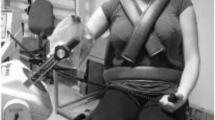Abstract
Background
This prospective study evaluated the development of proprioception over the course of 3 years after shoulder arthroplasty.
Methods
Twenty-one patients were enrolled who underwent total shoulder arthroplasty (n = 10) or hemiarthroplasty (HEMI) (n = 11) for shoulder osteoarthritis. All patients were examined 1 day before the operation, 6 months and 3 years after surgery in a motion analysis study with an active angle-reproduction (AAR) test.
Results
Overall proprioception measured by the AAR deteriorated significantly 3 years after surgery [from 6.6° (SD 3.1) to 10.3° (SD 5.7); p = 0.017] and was significantly worse than in the control group [10.3° (SD 5.7) vs. 7.8° (SD 2.3); p = 0.030). In the HEMI subgroup, 3 years after shoulder replacement, there is a significant deterioration of proprioception at 30° of external rotation [from 3.1° (SD 3.5) to 12.8° (SD 10.7); p = 0.031]. On average, in the TSA subgroup proprioception deteriorated from 7.1° (SD 3.1) to 8.6° (SD 1.4) and in the HEMI subgroup from 6.1° (SD 2.1) to 12.4° (SD 8.3). The comparison of postoperative impairment of proprioception between the TSA and HEMI subgroup showed significantly worse proprioception for the HEMI subgroup at 30° of external rotation [9.8° (SD 10.1) vs. 1.6° (SD 6.3) in the TSA group; p = 0.046].
Conclusion
In conclusion, proprioception that was measured by an AAR test remained unchanged or deteriorated 3 years after shoulder arthroplasty. The postoperative deterioration of proprioception was more distinctive in HEMI than in TSA group.





Similar content being viewed by others
References
Blasier RB, Carpenter JE, Huston LJ (1994) Shoulder proprioception. Effect of joint laxity, joint position, and direction of motion. Orthop Rev 23(1):45–50
Carman AB, Milburn PD (2006) Determining rigid body transformation parameters from ill-conditioned spatial marker co-ordinates. J Biomech 39(10):1778–1786
Chiari L et al (2005) Human movement analysis using stereophotogrammetry. Part 2: instrumental errors. Gait Posture 21(2):197–211
Constant CR, Murley AH (1987) A clinical method of functional assessment of the shoulder. Clin Orthop Relat Res 214:160–164
Cuomo F, Birdzell MG, Zuckerman JD (2005) The effect of degenerative arthritis and prosthetic arthroplasty on shoulder proprioception. J Should Elbow Surg 14(4):345–348
Deshmukh AV et al (2005) Total shoulder arthroplasty: long-term survivorship, functional outcome, and quality of life. J Should Elbow Surg 14(5):471–479
Doorenbosch CA, Harlaar J, Veeger DH (2003) The globe system: an unambiguous description of shoulder positions in daily life movements. J Rehabil Res Dev 40(2):147–155
Gamage SS, Lasenby J (2002) New least squares solutions for estimating the average centre of rotation and the axis of rotation. J Biomech 35(1):87–93
Gokeler A et al (2012) Proprioceptive deficits after ACL injury: are they clinically relevant? Br J Sports Med 46(3):180–192
Goodwin GM, McCloskey DI, Matthews PB (1972) The contribution of muscle afferents to kinaesthesia shown by vibration induced illusions of movement and by the effects of paralysing joint afferents. Brain 95(4):705–748
Habermeyer P, Engel G (2004) Surgical technique for total shoulder arthroplasty. Operat Orthop Traumatol 16:339–364
Jerosch J, Prymka M (1996) Proprioception and joint stability. Knee Surg Sports Traumatol Arthrosc 4(3):171–179
Kasten P et al (2009) Proprioception in total, hemi- and reverse shoulder arthroplasty in 3D motion analyses: a prospective study. Int Orthop 33(6):1641–1647
Kasten P et al (2010) Can shoulder arthroplasty restore the range of motion in activities of daily living? A prospective 3D video motion analysis study. J Should Elbow Surg 19(2 Suppl):59–65
Orfaly RM et al (2003) A prospective functional outcome study of shoulder arthroplasty for osteoarthritis with an intact rotator cuff. J Should Elbow Surg 12(3):214–221
Pötzl W et al (2004) Proprioception of the shoulder joint after surgical repair for Instability: a long-term follow-up study. Am J Sports Med 32(2):425–430
Proske U, Gandevia SC (2009) The kinaesthetic senses. J Physiol 587(Pt 17):4139–4146
Raiss P et al (2007) Range of motion of shoulder and elbow in activities of daily life in 3D motion analysis. Z Orthop Unfall 145(4):493–498
Rettig O et al (2009) A new kinematic model of the upper extremity based on functional joint parameter determination for shoulder and elbow. Gait Posture 30(4):469–476
Rockwood CA Jr (1990) The technique of total shoulder arthroplasty. Instr Course Lect 39:437–447
Rokito AS et al (2010) Recovery of shoulder strength and proprioception after open surgery for recurrent anterior instability: a comparison of two surgical techniques. J Should Elbow Surg 19(4):564–569
Smith JL et al (2009) Signals of motor command bias joint position sense in the presence of feedback from proprioceptors. J Appl Physiol 106(3):950–958
van de Sande MA, Brand R, Rozing PM (2006) Indications, complications, and results of shoulder arthroplasty. Scand J Rheumatol 35(6):426–434
Walch G, Boileau P, Pozzi P (1999) Glenoid resurfacing in shoulder arthroplasty. In: Walch G, Boileau P (eds) Shoulder arthroplasty. Springer, Berlin, pp 177–181
Walch G et al (1998) Primary glenohumeral osteoarthritis: clinical and radiographic classification. The Aequalis Group. Acta Orthop Belg 64(Suppl 2):46–52
Wise AK, Fallon JB (2002) The effect of muscle contraction on kinaesthesia. Adv Exp Med Biol 508:87–94
Wu G et al (2005) ISB recommendation on definitions of joint coordinate systems of various joints for the reporting of human joint motion—Part II: shoulder, elbow, wrist and hand. J Biomech 38(5):981–992
Acknowledgments
We thank the research fund of the Department of Orthopaedic and Trauma Surgery of the Hospital of the University of Heidelberg for the financial support of the study. Furthermore, we would like to thank the motion analysis team of the University of Heidelberg, especially Petra Armbrust and Waltraud Schuster, for the practical support during the study.
Conflict of interest
All authors, their immediate family, and any research foundation with which they are affiliated did not receive any financial payments or other benefits from any commercial entity related to the subject of this article.
Author information
Authors and Affiliations
Corresponding author
Rights and permissions
About this article
Cite this article
Maier, M.W., Niklasch, M., Dreher, T. et al. Proprioception 3 years after shoulder arthroplasty in 3D motion analysis: a prospective study. Arch Orthop Trauma Surg 132, 1003–1010 (2012). https://doi.org/10.1007/s00402-012-1495-6
Received:
Published:
Issue Date:
DOI: https://doi.org/10.1007/s00402-012-1495-6




